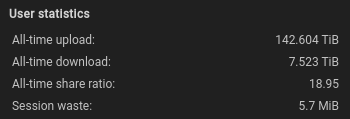

Codeberg looks pretty good at a quick glance.


Codeberg looks pretty good at a quick glance.
Duck typing moment


You’re not wrong, but it bugs me when my ratio drops, so I always seed everything I download. I have a pretty good internet service though.
My stats:



It’s when you open a publicly facing port and map (forward) it to a local port your machine. In this case, it’s opened at the vpn provider’s public gateway. Otherwise, it would typically be opened in your router instead.
You can then configure your torrent client to listen on that local port that the public port is forwarded to. I think generally the public and the local port are the same number when using VPN.
If you do that, then others have the ability to initiate a connection to you instead of only you being able to initiate the connection to somebody else.
When seeding/leeching to/from someone else, at least one of you needs a port open. So, if you always have one open, you allow yourself to connect to anyone on the network regardless if they have one open or not.
Sorry if I confused you more, I’m not that great at explaining.


I seed without cap, don’t really need my upload for anything else. (500 Mbps)
What’s the distro? I can help seed it indefinitely with open ports.


Huh? Yes it does. Unless you mean it’s not cracked yet.


deleted by creator


PF works with proton, I use it. But you have to continuously call it to stay open. (On linux)


What i found to work the best is to generate and download a config file, then import it into NetworkManager. There’s a plugin for wireguard here: https://github.com/max-moser/network-manager-wireguard
This way, it’s easy to add routes, autostart, etc. But I don’t think a safe killswitch is possible.
Edit: But since this is a piracy community, i should mention that qbittorrent has a setting for specifying the network interface, so it’s easy to force it to use the vpn connection only, in place of a killswitch.


It seems to me that you misunderstand what artificial intelligence means. AI doesn’t necessitate thought or sentience. If a computer can perform a complex task that is indistinguishable from the work of a human, it will be considered intelligent.
You may consider the classic turing test, which doesn’t question why a computer program answers the way it does, only that it is indiscernable from a human response.
You may also consider this quote from John McCarthy on the topic:
Q. What is artificial intelligence?
A. It is the science and engineering of making intelligent machines, especially intelligent computer programs. It is related to the similar task of using computers to understand human intelligence, but AI does not have to confine itself to methods that are biologically observable.
There’s more on this topic by IBM here.
You may also consider a few extra definitions:
Artificial Intelligence (AI), a term coined by emeritus Stanford Professor John McCarthy in 1955, was defined by him as “the science and engineering of making intelligent machines”. Much research has humans program machines to behave in a clever way, like playing chess, but, today, we emphasize machines that can learn, at least somewhat like human beings do.
Artificial intelligence (AI) is the field devoted to building artificial animals (or at least artificial creatures that – in suitable contexts – appear to be animals) and, for many, artificial persons (or at least artificial creatures that – in suitable contexts – appear to be persons).
artificial intelligence (AI), the ability of a digital computer or computer-controlled robot to perform tasks commonly associated with intelligent beings
That would be similar to saying you are assuming the user has opened the gui application, not just randomly clicking the desktop.
Of course I’m assuming they already know what application they want to use before exploring its capabilities.
$ command -h
$ command --help
$ man command
I have a lot of tab completions installed, too, so i can also just hit tab to get a list of all possible options, etc.


There’s definitively more to a distro than the shell prompt and wallpaper.
Besides the obvious package repos and how well package interoperability is maintained, there’s also differences for default configuration. OpenSUSE offers sane options for security OOtB, IMO.
Then there’s also linux itself. Some distros build the default kernel package with a set of patches to improve typical usability, while others just ship an untouched upstream version. Some offer alternatives while others don’t.


More bloat from flatpak overhead :^)


I’m a simple man, I just search directly in qbittorrent.


At least to my understanding. My model is the T14 Gen 1 (AMD). But I would recommend checking newer models.
A few points that indicates this:
It’s possible to order it with linux preinstalled:
In limited countries or regions, Lenovo offers customers an option to order computers with the preinstalled Linux® operating system. - User Guide, Appendix C
Ubuntu 20.04 certification: https://ubuntu.com/certified/202006-27980
RHEL 8.3 certification: https://catalog.redhat.com/hardware/detail/71625
There’s a “Linux Certification” page (whatever that means): https://support.lenovo.com/au/en/solutions/pd500492
The BIOS software comes with linux instructions. Though I just use whatever is available with fwupd, which is a CLI application but has GUI support through Gnome with gnome-firmware.
More info about linux support here, under “Notebooks and Laptops”: www.lenovo.com/linux
A million edits later: I got confused by what the product ID was but I think I finally figured it out.


My thinkpad model officially supports linux, so there is no problem there. It is also much cheaper than any of those brands, and it’s also available from the regular stores.
I don’t discover it any certain way but once I know what I’m looking for I just search in qbittorrent. For anime I have RSS feeds set up.
I download.
Internal storage, currently some SSDs.
mpv + fsr/Anime4K shaders.
I use trackma/taiga with MAL for anime, for regular shows/movies I don’t use anything.